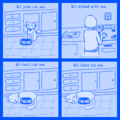Láadan/Lessons/2
Verb CP-S
[edit | edit source]Let's start out with really a really simple sentence structure, [Verb Case-Phrase-Subject]. This is how sentence structures are described in the official Láadan book.
With this form, we can make sentences like: [Noun] is [Adjective], [NounA] is [NounB], and [Noun] does [Verb].
Word Types
[edit | edit source]In Láadan, there isn't the concept of nouns, verbs, and adjectives like in English. The two word classifications are content words and function words. (Suzette Haden Elgin, Lesson One - Things You Need To Know For Learning Láadan)
This generally means that words in Láadan can function as both verbs ("to be red") and adjectives ("red") and nouns ("the color red").
Sentence structure is expected to fall in a certain order in order to make sense of the sentence, though there are also affixes that can be added to words to flesh out a sentence (such as adding an object marker for an item being acted upon.)
Simple Sentences
[edit | edit source]Here are some vocabulary words: omá - teacher, with - person, balin - old, om - to teach.
To say, "The person is old", the sentence would be "Bíi balin with wa."
To say, "The person is a teacher", the sentence would be "Bíi omá with wa."
To say, "The person teaches", the sentence would be "Bíi om with wa."
Same sentence structure in both cases. For now, we're ignoring bíi and wa, but we will cover these words soon. Also note that Láadan does not have words for "a" or "the". (Suzette Haden Elgin, Lesson One - Things You Need To Know For Learning Láadan).
This will be our starting point for Láadan sentences. With this simple form, we can say three different kinds of sentences, using nouns, adjectives, and verbs - because, remember, these are all content words rather than separate classifications in Láadan.
Examples
[edit | edit source]Here are some example sentences using the form [Verb Case-Phrase-Subject].
| Láadan | English | Vocab words |
|---|---|---|
| Bíi áya nanáal wa. | The sunset is beautiful. | áya = beautiful, nanáal = sunset |
| Bíi lith háawith wa. | The child thinks. | lith = to think, háawith = child |
| Bíi elash rul wa. | The cat plays. | elash = to play, rul = cat |
| Bíi bodibodá le wa. | I am a programmer. | bodibodá = programmer, le = me |
| Bíi bedihá ne wa. | You are a student. | bedihá = student, ne = you (singular) |
Practice: Sentence Building
[edit | edit source]Practice the [Verb Case-Phrase-Subject] sentence form by building your own sentences! Use a Láadan dictionary, or the word bank below, for help.
Word Bank:
| Láadan | English |
|---|---|
| balin | old |
| rabalin | young |
| omá | teacher |
| with | person |
| háawith | child |
| rul | cat |
| lanemid | dog |
| elash | to play |
| lalom | to sing |
| áana | to sleep |
Practice: Quiz
[edit | edit source]Translate these sentences from Láadan.
- Bíi elash háawith wa.
- Bíi lalom with wa.
- Bíi áana rul wa.
Answers
[edit | edit source]- The child plays
- The person sings
- The cat sleeps
Practice: Reading
[edit | edit source]Use a Láadan dictionary to read the simple sentences in this comic.
-
Lesson 2 Comic



